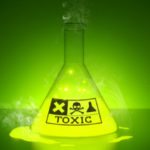 Misconceptions
Misconceptions  Misconceptions
Misconceptions  History
History 10 Amazing Roman Epitaphs
 Weird Stuff
Weird Stuff 10 Niche Subcultures That Are More Popular Than You Might Think
 Mysteries
Mysteries 10 Tragic Disappearances and Deaths in Joshua Tree National Park
 History
History 10 Ways Childhood Really Sucked in the Old West
 Music
Music 10 Name Origins of Famous Bands from the 1990s
 Religion
Religion 10 Biggest Turnarounds by the Catholic Church
 Weird Stuff
Weird Stuff 10 Unbelievable Times Laws Had Unintended Consequences
 Humans
Humans Ten Historic Women Who Deserve Way More Credit Than They Got
 Movies and TV
Movies and TV 10 Films That Spawned Major Lawsuits
 Misconceptions
Misconceptions 10 Phony Myths and Urban Legends That Just Won’t Die
 History
History 10 Amazing Roman Epitaphs
 Weird Stuff
Weird Stuff 10 Niche Subcultures That Are More Popular Than You Might Think
Who's Behind Listverse?

Jamie Frater
Head Editor
Jamie founded Listverse due to an insatiable desire to share fascinating, obscure, and bizarre facts. He has been a guest speaker on numerous national radio and television stations and is a five time published author.
More About Us Mysteries
Mysteries 10 Tragic Disappearances and Deaths in Joshua Tree National Park
 History
History 10 Ways Childhood Really Sucked in the Old West
 Music
Music 10 Name Origins of Famous Bands from the 1990s
 Religion
Religion 10 Biggest Turnarounds by the Catholic Church
 Weird Stuff
Weird Stuff 10 Unbelievable Times Laws Had Unintended Consequences
 Humans
Humans Ten Historic Women Who Deserve Way More Credit Than They Got
 Movies and TV
Movies and TV 10 Films That Spawned Major Lawsuits
Top 10 Rare And Terrifying Complications From Common Occurrences
Every choice we make comes with the rare possibility of suffering from an unlucky complication of that decision. Many lists have been written on individual anecdotes about freak accidents, but fewer have been written on the specific activities. This list compiles ten extremely rare complications or diseases that can come from the everyday decisions we make or from situations that occur.
This list isn’t meant to generate unnecessary fear or anxiety about any of these topics because the odds of any of these happening to you are extremely low. Rather, it is meant to bring awareness to the complications that some extremely unlucky people have faced after entering some extremely common scenarios. If you suffer from any form of hypochondriasis or illness anxiety, you probably shouldn’t keep reading.
10 Hot Tea

Our body is made up of various types of tissue, depending on the normal stresses that it goes through. It’s fascinating how the tissues in our body have the ability to adapt based on the different environment pressures that are put on it. For example, our lungs are normally made up of more glandular tissues, but in the event of prolonged smoking, the tissues can turn into more “wear and tear” type tissues known a squamous cells, which can lead squamous cell carcinoma.
One of the extremely interesting and rare cancers that can occur based on human choice is esophageal cancer in habitual hot tea drinkers who also smoke and drink alcohol. Researchers have noticed that esophageal cancer risk in places where many drink hot tea daily (again, combined with smoking and drinking alcohol) is five times higher.[1]
It makes sense that as the cells try to regenerate and change following continuous trauma from piping hot tea, cigarette smoke, and alcohol, there is a higher likelihood that one of these cells may mutate and become out of control, leading to cancer. While habitual drinking of hot tea does not in any way guarantee that you’ll get esophageal cancer, it may be something to think about next time you’re enjoying your favorite afternoon beverage.
9 Nosebleeds

Nosebleeds are common occurrence, with 60 percent of people reporting a nosebleed at least once in their life. Most nosebleeds are self-limiting and just require a head tilt and a tissue for a few minutes until the bleeding stops. Other nosebleeds can be much more severe and require a trip to the emergency room for more advanced packing.
Most people have heard of the dreaded toxic shock syndrome (TSS) as a tampon-related illness. What many don’t know is that TSS is not limited to females and tampons. TSS can be caused by the bacteria Staphylococcus aureus, which normally hangs out around our noses. Because of this, there has been a report of a girl developing TSS from her nasal packing following nasal surgery.
Such an occurrence led many doctors to wonder if they should be giving their patients antibiotics for prolonged nosebleed packing to prevent possible TSS. The studies that have been run on this showed that antibiotics did not change any infection outcomes vs. patients who did not receive antibiotics following a nasal packing.[2] TSS following nasal packing is an extremely rare complication, and the only known cases are following surgeries. While it is theoretically possible for patients to develop TSS following a nosebleed packing, the packing should not be left in long enough for this to ever occur.
8 Strep Throat
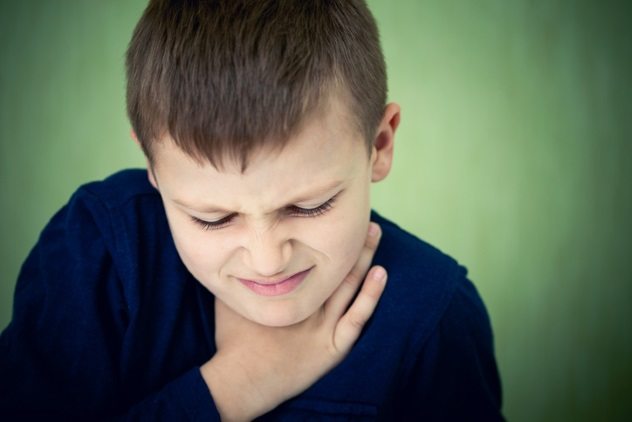
While you may have never heard of the bacteria Streptococcus pyogenes, many of us have been affected by it. This is the germ that commonly causes strep throat as well as impetigo. It’s not an extremely common complication, but three weeks after the initial infection, some children can go into sudden kidney failure in a disorder known as acute poststreptococcal glomerulonephritis (APSGN).
This occurs as the body builds up a defense against the strep infection through antibodies and complement proteins. For some strange reason, instead of continuing to attack the bacteria, the antibodies and complement proteins begin to deposit near the small blood vessels in the kidneys, causing widespread inflammation. Clinically, this can cause fever, swelling, high blood pressure, and cola-colored urine in the patient as the kidneys are acutely injured.
Treatment for this rare complication is mainly supportive, consisting of controlling the child’s blood pressure if it gets too high and controlling their potassium. Typically, this disorder resolves on its own, but it does have the potential to be deadly. In 2013 alone, poststreptococcal glomerulonephritis accounted for about 19,000 deaths. In the past two to three decades, the incidence of APSGN has been decreasing, and this disease more commonly affects those with compromised immune systems. Still, the estimated incidence of APSGN worldwide is about 427,000 cases per year.[3]
7 Surfing
 Leptospira is a genus of bacteria known as a spirochete, which is a spiral-shaped bacteria. It can be passed to humans in the urine of wild or domestic animals and can sometimes end up in places that we would not expect. This infected animal urine can get washed into the coastal or recreational waters that we use, causing widespread infection. The pathogen enters our body when the animal urine comes into contact with an open wound or through your eyes, nose, or mouth.
Leptospira is a genus of bacteria known as a spirochete, which is a spiral-shaped bacteria. It can be passed to humans in the urine of wild or domestic animals and can sometimes end up in places that we would not expect. This infected animal urine can get washed into the coastal or recreational waters that we use, causing widespread infection. The pathogen enters our body when the animal urine comes into contact with an open wound or through your eyes, nose, or mouth.
A group of people who are particularly affected by leptospirosis are those who partake in water sports, such as surfers, whitewater paddlers, or rowers.[4] If not treated correctly, leptospirosis can progress to an extremely serious condition known as Weil’s disease. This involves kidney failure and bleeding, which can eventually lead to severe lung hemorrhage and death. In fact, Olympic rowing champion Andy Holmes died in 2010 after contracting leptospirosis, which developed into Weil’s disease, through some open blisters.
On its own, symptoms of leptospirosis can range from asymptomatic to fevers, eye redness, myalgia, and headaches. Ninety percent of leptospirosis cases are mild and do not develop into Weil’s disease. Thankfully, if it is caught, it can be treated with an antibiotic such as doxycycline.
6 Popping A Zit

If you have ever tried popping a zit on your face, someone may have warned you about the possible rare and dangerous complication of this. An area that stretches from the corners of your mouth to the bridge of your nose is commonly known as the “triangle of death.” The area received its name because of the rare possibility that any infections here can move up and into your brain.
There is an area in your brain known as the cavernous sinus, which contains some veins, arteries, and nerves. This sinus is an extremely important area for venous drainage of the brain. One vein that drains into this sinus is known as the facial vein. The facial vein is connected to the ophthalmic vein, which drains the triangle of death.
An infection in the cavernous sinus can cause the blood in the sinus to coagulate, creating a clot that can push against the various nerves and arteries that also flow through the sinus. This can lead to various palsies of the face based on what is compressed, ranging from blindness to muscle paralysis.[5]
While this all sounds terrifying and theoretically possible, it has only ever occurred in very rare circumstances. It is very uncommon to get a cavernous sinus thrombosis from the death triangle in general and almost impossible to get it from a simple zit. It would instead require a zit to become extremely infected and cause cellulitis or turn into a furuncle or abscess. Once the infection develops, it would only have a short distance to travel to reach the brain. However, we are living in the age of antibiotics, so it is likely that the infection would get treated long before it ever got large enough to cause a cavernous sinus thrombosis.
5 Rear-End Collisions

A car accident can result in many types of injuries, depending on various factors of the crash. With so much bumper-to-bumper traffic nowadays, it’s not hard to imagine that rear-end collisions are by far the most common type of motor vehicle accident. Many of us reading right now have probably been directly or indirectly involved in a rear-end collision. While the vast majority of people are extremely familiar with the injuries that can result from a rear-end collision, one of most rare and terrifying possibilities is that of central cord syndrome.
Central cord syndrome results when the middle portion of the spinal cord is injured. While you may think that this area should be the most protected part of your spinal cord, it can be surprisingly easy to injure it in any type of trauma that involves forced hyperextension of your neck, such as a rear-end collision. The results of this injury can be debilitating. Victims suffer paralysis or burning pain in their upper extremities, while their lower extremities can be spared. In addition to the paralysis, victims can have varying amounts of sensory loss as well as possible urinary retention, also known as neurogenic bladder.
Treatment for this injury can be very expensive, including an extended hospital stay, physical therapy, occupational therapy, and surgery.[6] On top of all of this, there is a strong chance that the victim may never fully recover. So next time you think about tailgating the car in front of you, you may want to think again.
4 Liposuction
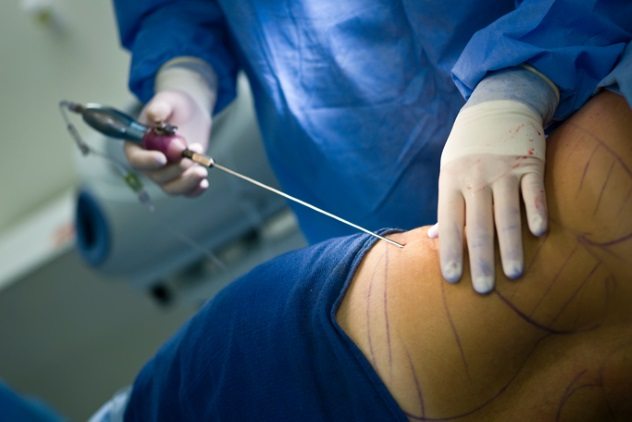
Liposuction is becoming a pretty common cosmetic procedure for many people hoping to decrease their body fat percentage. One extremely rare and dangerous complication of liposuction is what is known as a fat embolism. Our bones and tissues are all filled with a certain amount of fat, which can be released into our body during the liposuction procedure. This phenomenon is also fairly common in patients who sustain multiple long bone fractures in trauma. Similarly to liposuction, when people suffer from multiple fractures, this fat can be released into the body and go to places that it shouldn’t.[7]
One to three days following the trauma or procedure, patients who suffer fat embolism syndrome may develop fever, racing heart, rash, and full-blown respiratory failure. These symptoms occur as the fat emboli move throughout the body and lodge themselves in places such as the lungs. Rarely, these fat emboli can even move up to the brain, resulting in a sudden and unexpected coma.
While this complication is almost nonexistent in patients with minor injuries and a majority of liposuction procedures, it can occur in up to 90 percent of major trauma patients. Fat embolism syndrome is mainly a clinical diagnosis, which means that doctors won’t know that you have this until you start experiencing symptoms. Fat embolism syndrome can be extremely deadly if it is not recognized and treated early and aggressively. If it is caught early, mortality drops to only ten percent.
While a fat embolism may seem terrifying, it is extremely, extremely rare for it to happen to a patient undergoing liposuction, and only a few case studies exist, despite the thousands of people who have undergone the procedure. It is more common in major trauma with multiple long bone fractures.
3 Neti Pots

The so-called “brain-eating amoeba” has gotten a lot of press attention lately as lakes begin to heat up more than ever before. The real name of the amoeba is Naegleria fowleri. Most are familiar with the amoeba’s typical environment of warm freshwater lakes, rivers, or poorly chlorinated pools. What is less known is that N. fowleri can get into products that hit much closer to home.
A neti pot is a product that can be used to clean out your sinuses. It involves filling a teapot-looking apparatus with warm saline and essentially dumping it through one nostril and out the other. Cases of those who have passed away from Naegleria after neti pot use were because they used tap water, rather than sterile water. The amoeba can then usually be found colonizing the victim’s water heater or faucet.[8] Horrifyingly, this is the perfect route for Naegleria to access the victim’s brain. The amoeba is known to enter the victim’s nostrils and travel up through what is known as the cribriform plate, which features little holes in the skull, gaining access to the brain and meninges.
Death occurs in 99 percent of Naegleria cases and happens quickly, within a span of about five days. Despite these dismal survival statistics, it is extremely rare to contract, with only 32 reported infections between 2002 and 2011, despite the millions and millions of people exposed to multiple different places where Naegleria could live.
2 Dental Procedures
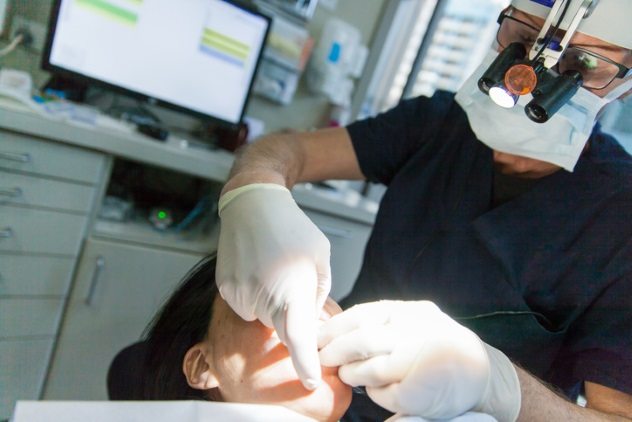
As medical students study for their board exams, they practice a lot of questions that involve patients in clinical vignettes. One of the most knee-jerk vignettes that they receive is a patient who just underwent a routine dental procedure and now has an infection in his heart.[9]
As far-fetched as it may sound, it is possible. You may have wondered why dentists prescribe prophylactic antibiotics to certain patients before they receive dental procedures, and this is one reason why. Our mouths are extremely full of nasty bacteria. In fact, human bites are bacteriologically one of the dirtiest bites that someone can get. In a dental procedure, while extremely rare, it is possible for some of this bacteria to get dislodged and enter our bloodstream.
Once in our vessels, this bacteria can latch onto our heart valves if they are already damaged or prosthetic. The damaged or prosthetic valve makes the perfect net to catch some of this bacteria and allow it to grow and flourish. This can result in a disorder known as endocarditis, or inflammation of the inner lining of the heart. The most common bacteria from our mouth to do this is from the viridans streptococci group.
Clinically, many do not initially know that they have this infection, as it is subacute and develops gradually. Soon, the patient may develop fatigue, sweating, fever, painful nodules on their body, or splinter hemorrhages under their nails. While this rare occurrence may sound scary, it can be treated with antibiotics if it is caught. People with normal, healthy heart valves have nothing to worry about, as the bacteria cannot latch on. Thankfully, there are also guidelines for when and who to give antibiotics prior to any dental procedures, so this complication can be avoided.
1 Sneezing
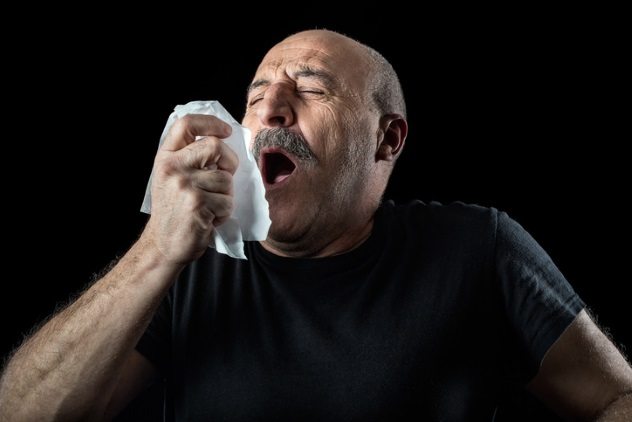
Sneezing can be a dangerous activity. Whether you let it go or stifle it, there are extremely rare complications that can occur either way that can leave you deaf, dizzy, or even dead. A sneeze is a reflex that we have developed to get rid of irritants in our noses by forcefully expelling them. Now, this begs the question of what is less dangerous: to let it out or to hold it in? According to Dr. Wild, an ENT at the St. Louis University School of Medicine, just let it out.
Plugging your nose to stop a sneeze can lead to several pretty bad outcomes. These include injuring your diaphragm, breaking a vessel in your eye, rupturing your eardrum and causing deafness or vertigo, rupturing a vessel in your brain, rupturing an aneurysm, or even rupturing your throat.
On the flip side, aggressive sneezes aren’t very fun, either. If you swing too much the other way, an aggressive sneeze can lead to a headache or stroke if you’ve had previous sinus surgery, the development or rupture of a brain aneurysm, momentary incontinence, or our old friend central cord syndrome from hyperextension of your neck.[10]
While the event of an aneurysm after a sneeze is extremely rare to begin with, it usually occurs in a person with previously weakened vessels. Most of the complications of sneezing come from only anecdotal cases, as they are so rare. Regardless, next time you feel the urge to sneeze, it’s probably better to just follow through.
+ High-Voltage Electric Shock
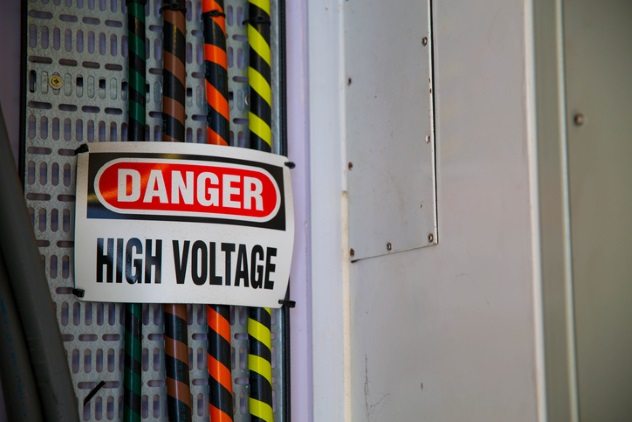
While thankfully not a common enough occurrence to make it to the main body of the list, a high-voltage electrical shock can have numerous negative effects on the body. Many are aware of the more common outcomes of such a shock, such as a burns, heart arrhythmia, and death, but its effects on our muscles are much less widely known.
Our bodies as a whole rely heavily on the electrical currents flowing through them. All of the ions that shift from our cells create electricity that helps power the functions that our body needs to survive.
Stories of superhuman strength from people doing drugs like PCP showcase the potential of our muscles, whether or not we know how to harness it. In a high-voltage electrical shock, some people actually suffer from bilateral posterior shoulder dislocations as their muscles experience such massive contractions that the humerus, or arm bone, is actually ripped out of its socket.[11] Not only can injuries like this happen in high-voltage electrical shock, but they have also been reported following seizure activity.
Read about more terrifying medical occurrences on 10 Dreadful Symptoms Of Deadly Diseases and 10 Horrifying Tales Of Flesh-Eating Diseases.
